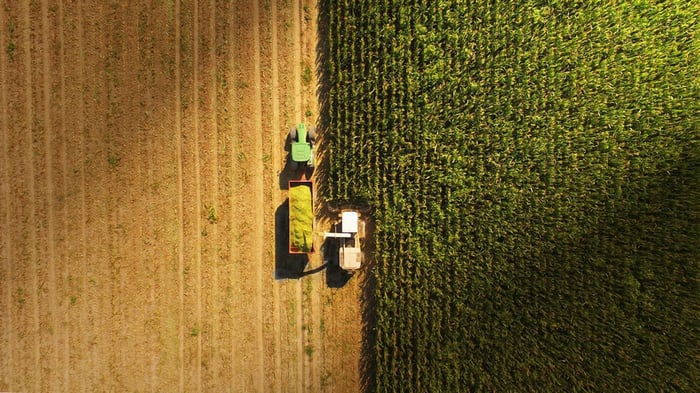Going from a concept in 2015 to beta service in 2021, SpaceX's plan to build a network of fast internet communications satellites has grown from 0 to 10,000 to 2.2 million active users (according to a December 2023 SpaceX filing with the FCC). Across several business lines, the company now offers globe-spanning satellite internet service to homeowners (Starlink Residential), businesses (Starlink Business), airline customers (Starlink Aviation), cruise customers (Starlink Maritime), and even RV owners (Starlink Roam).
And now it's time to sign up some farmers.

Image source: Getty Images.
Starlink + John Deere = more money for SpaceX
The news struck like a thunderbolt out of a clear blue sky. On Jan. 16, agricultural tractor powerhouse Deere & Company (DE -0.18%) announced it had signed a contract with SpaceX "to provide cutting-edge satellite communications" that will empower farmers "to fully leverage precision agriculture technologies."
SpaceX will design new "ruggedized satellite terminals" that can be installed in both new and existing agricultural machines to enable "autonomy, real-time data sharing, remote diagnostics, enhanced self-repair solutions, and machine-to-machine communication." These terminals will in turn allow various tractors, combines, harvesters, and other agricultural machines to communicate with each other via satellites circling overhead, and also to the John Deere Operations Center for coordinating their work.
Deere confirmed that the new service will be begin rolling out to farmers in the United States and Brazil in the second half of 2024.
Commenting on the news, Gizmodo noted that Deere already produces self-driving tractors that, with help from Deere's Ops Center, can drive themselves autonomously. "But adding online connectivity to the agricultural machinery will allow farmers to monitor it in real-time and send commands if needed." FierceWireless.com explains that Deere's Ops Center mines "data from sensors and smart cameras deployed on John Deere's tractors" to give farmers "a real-time view of their equipment, as well as status reports about the land they're working on." In turn, this permits farmers to pick the optimal times and places to plant their wheat and soy, to irrigate, to deploy fertilizer (a huge expense in farming), and to harvest.
Of particular importance: Many crops within a given area require all of these activities to take place within a very short period of time (i.e. "Right now! Before it rains!") to maximize productivity. The more real-time data farmers have, the better use they can make of scarce resources (both machines and labor) to use those crucial time periods efficiently.
How much is this worth to Starlink -- and to Deere?
So now you can see why this new service would be attractive to farmers. It's going to lower costs, improve efficiency, and mean more profit per acre farmed.
This partnership is also going to be attractive to SpaceX, which has to space out its satellites equally all around to globe to ensure universal satellite internet coverage, regardless of where population centers are. This leads to a situation where some Starlink satellites are working hard to keep up with bandwidth demands, while other satellites remain chronically underutilized.
Tapping the agricultural market is a great way to increase utilization of underutilized satellites over underpopulated agricultural areas. But what does this deal mean for SpaceX -- and for Deere -- in terms of dollars and cents?
Well, the companies didn't say exactly. But DataCenterDynamics.com notes that "John Deere aims to generate 10 percent of its annual revenue from software service fees -- which can provide real-time data to farmers," and that at least gives us a ballpark to aim for. Deere, for example, generated $61.2 billion in total revenue over the last 12 reported months, according to data from S&P Global Market Intelligence. So we could be looking at as much as a $6 billion revenue opportunity here for Deere.
The profit opportunity could be substantial as well. Services revenue is generally higher-margin than manufacturing, and Deere already earns about $10.2 billion a year in profit as a manufacturer. Deere could therefore be looking at an extra $1 billion or more in profit on the services it will be able to provide thanks to its partnership with Starlink.
How much of this revenue and profit Deere ends up sharing with SpaceX remains to be seen. One thing seems certain, though: The more revenue and profit Starlink can generate for the company, the more likely we are to see a Starlink IPO in the near future.





